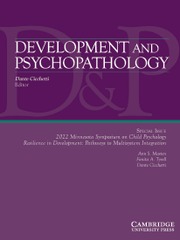No CrossRef data available.
Article contents
A systematic review of stress-adapted skills and hidden talents in individuals who faced early adversity
Published online by Cambridge University Press: 24 October 2025
Abstract
Traditionally, early life adversity research has focused on negative outcomes. Contrastingly, the hidden talents framework asserts that many individuals develop specialized abilities as a direct result of their adversity exposure. This framework serves as the foundation for the current study, which systematically reviews extant empirical studies investigating hidden talents or stress-adapted skills in individuals who have experienced early adversity. Synthesizing data through a developmental lens, this review examines how these skills manifest at different stages of development. Guided by the Preferred Reporting Items for Systematic Reviews and Meta-Analyses, we searched four databases and identified 45 eligible studies. Data on country of origin, sample size, predictor and outcome themes, and participant characteristics were extracted. Categorized into cognitive, social, and physiological domains, findings reveal that early adversity was associated with adaptive skills aligned with environmental demands (e.g., heightened emotional awareness, intuitive decision-making, empathy). While cognitive adaptations were the most studied, social and physiological adaptations remain underexplored. Some studies also reported null effects. Future directions include calls for examination of developmental pathways, longitudinal designs, diverse sampling, and culturally responsive approaches to better understand hidden talents and inform strength-based interventions.
Information
- Type
- Regular Article
- Information
- Copyright
- © The Author(s), 2025. Published by Cambridge University Press


